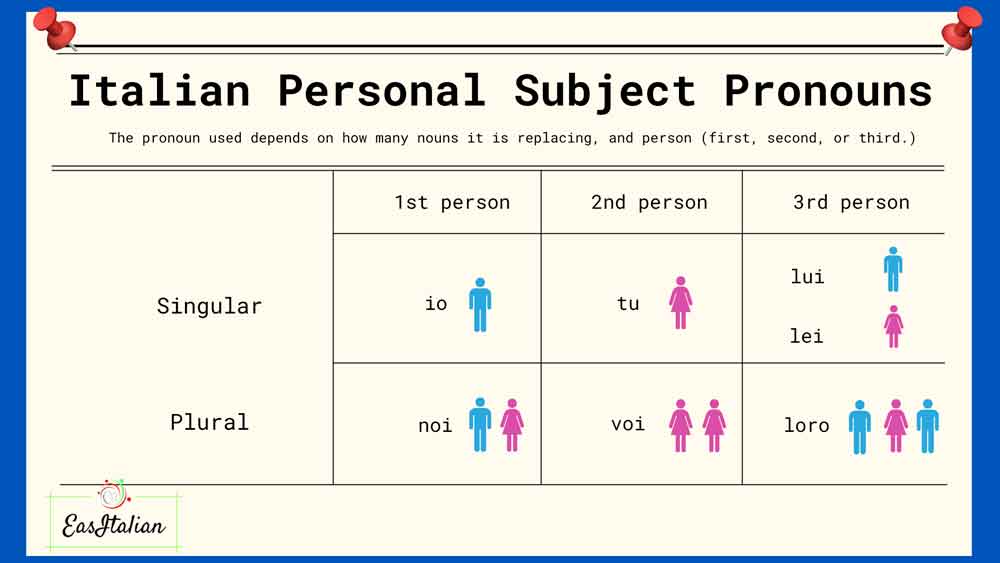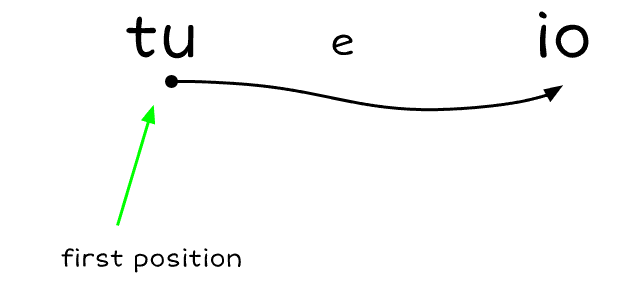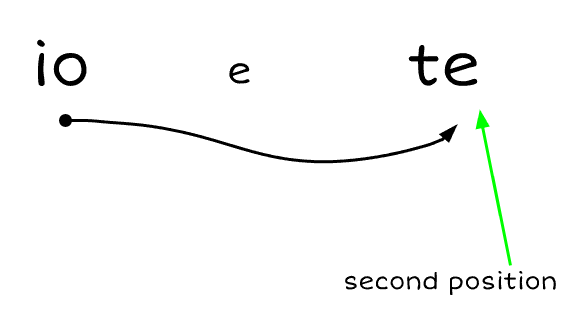What is a subject’s personal pronoun?
The Italian subject personal pronouns are those that indicate who does the action in a sentence in Italian and in many different languages. They replace the subject of a sentence and are used to avoid repetition, or where a name is not known.
Do you know how to use adjectives with prepositions like interested in or similar to?
Look at these examples to see how personal pronouns are used.
🔸 Marco non viene a cena – Lui non viene a cena
Examples:
🔸 Anna va al mercato – Lei va al mercato
🔸 Anna e Marco hanno telefonato – Loro hanno telefonato
► Read the explanation to learn more.
In these sentences, we do not say the subject’s name, but we replace it with the pronoun.
In Italian, in most of the sentences, you don’t need subject personal pronouns because the ending of the verb indicates the person and the number of the subject. Past participles, adjectives, and nouns used as qualifiers may convey gender and number as well.
But sometimes you need the subject pronoun.
When do you need subject pronouns in Italian?
You need pronouns in Italian:
• To emphasize the subject. Io ho dato le dimissioni, alla fine.
Example:
Chi ha fatto la spesa? L’ho fatta io. (Who went to the groceries? I went)
• when there is a comparison of one subject over another, often inverting the subject + verb word order.
Examples:
Io lavoro dalla mattina alla sera, mentre tu dormi tutto il giorno. (I work from morning to night, while you sleep all day)
🔸 Ha ragione lei, non lui. (She is right, not he.)
Io sono italiano, lui è americano, lei è spagnola (I’m Italian, he’s American, she’s Spanish)
Io pulisco sempre ma tu non fai mai niente
• With verb forms (especially the subjunctive) that could generate confusion about the agent.
Example:
Penso che tu non sia contento. (I think that you aren’t happy.)
• When you use words like anche neanche neppure nemmeno
Examples:
Anche noi siamo andati al mare.
Me l’ha detto anche lei ma non le credo.
What are the subject’s personal pronouns?
There are six basic persons (persone). Only the third singular person takes different forms.
They are not capitalized unless they follow a punctuation mark that requires the next word to be capitalized.
singolare (1 person) 👤
io – tu – lui/lei
Plurale (2,3 and more people) 👥
noi – voi – loro

Subject pronouns like egli, Ella, and essa were frequent in the past, but not anymore.
Egli/ella essa are exclusively used in very formal situations (literary or academic texts) in modern Italian. They are supplanted in modern Italian by lui and lei in the singular, and loro in the plural.
- Egli/esso ☞ lui
- Ella/essa ☞ lei
- Essi ☞ loro
- Esse ☞ loro
Italian personal pronouns: formal or informal?
In Italian there is a familiar, informal address (dare del tu) and a polite, formal address (dare del Lei):
In Italian, use the subject tu ( + the verb in the second person singular ) when there is an informal relationship between the speaker, the subject and another person.
📌 Use Lei (+ the verb in the third person singular) as a form of courtesy to address people formally.
Therefore, in consideration of the form of courtesy, Lei is the personal pronoun that one should use to address both a man and a woman.
Was this response better or worse?BetterWorseSame
To distinguish it from the personal pronoun female subject, you’ll find it with a capital L – Lei, in written Italian.
Do you think this Lei could be sometimes confusing in speaking the language?
The answer is yes, sometimes.
Example: Viene anche lei al concerto?
With this kind of question, you maybe are not sure if the person is using the form of cortesia or is speaking maybe about your sister. Funny!
📌 Voi (+ the verb in the second person plural ) is the subject pronoun for a group of people, in formal and informal contexts. In the past the pronoun Loro was common but in today’s Italian, it is infrequent to find the pronoun Loro to address people formally except in very formal situations.
Example: Signori, loro che cosa desiderano? Signori che cosa desiderate?
Very formal

Standard Italian

Double Subjects pronouns
When you mention more than one subject, the verb is always in the plural.
Different form for the second person singular – Tu or te? 🤔
Sometimes tu becomes te. Here’s why:
When you use.io and tu together as subjects, the personal pronoun tu can change according to the position in the sentence:
If tu is in the first position it remains unchanged (tu e io),
while it becomes
te if it is in the second position (io e te).


This te is a legacy of the Latin complement conveying company teco meaning con te (with you).
Subject PRONOUNS IN OTHER LANGUAGES
Italian does not use any pronoun where English uses it: for example with impersonal verbs and expressions such as piove, nevica, , accade, capita, succede, bisogna, è importante, è necessario.
It’s raining ☞ piove
It’s important ☞ È importante
In English, French and German, personal pronouns according to the subject are always expressed (I go, je vais, ich fahre= io vado), while said before, in Italian they are often implied.
Do you want to know more about Italian pronouns?
What’s next?
You might want to keep learning Italian online with these free resources:










Leave a Reply